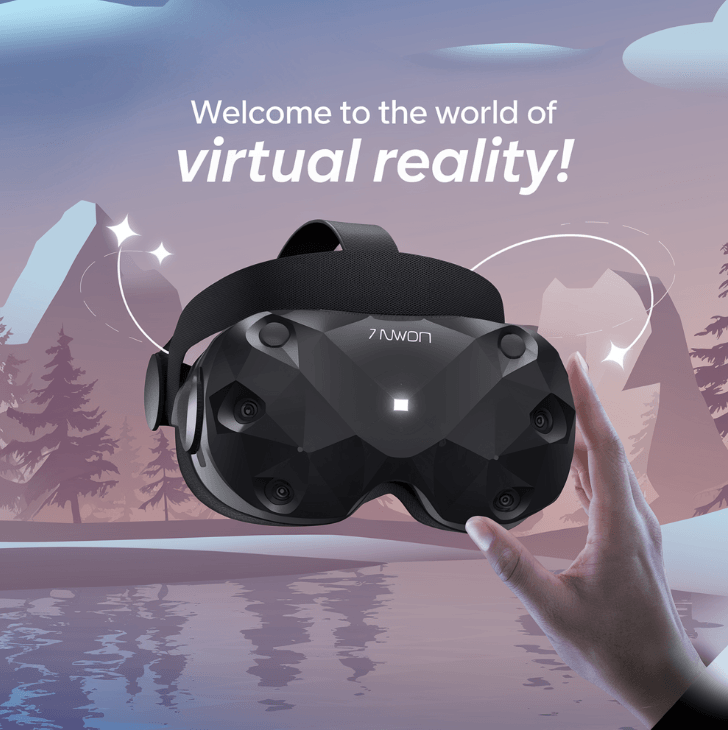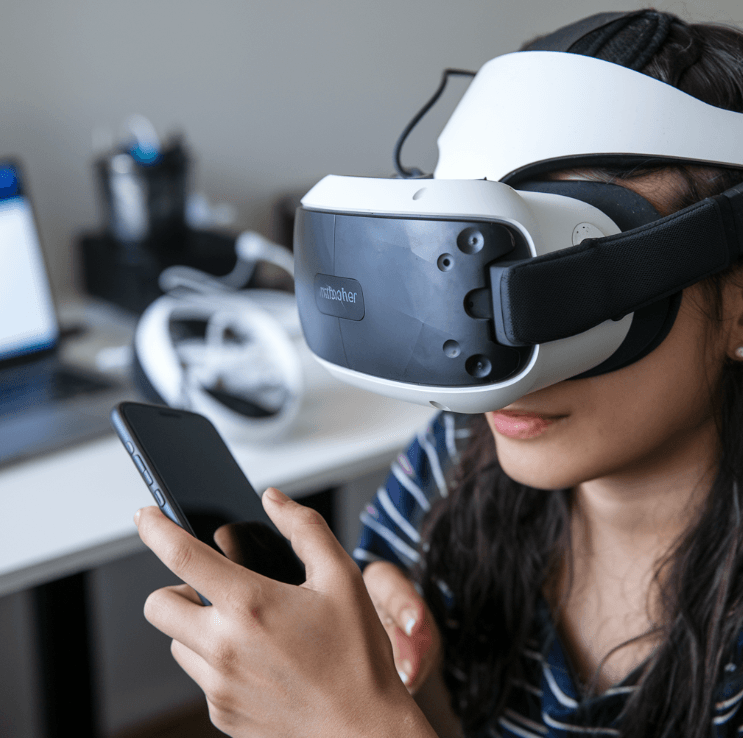Introduction
Nowadays technology is developing very fast, and in this time two such terms which are heard a lot are the terms is Augmented Reality (AR) and Virtual Reality (VR). But some people consider both technology to be the same, while these two technologies are completely different. If you do not know what is the difference between AR and VR, then you have come to the right place, in this article we will completely guide you what is the difference between AR and VR. In this article we will discuss about the difference between augmented reality and virtual reality.
What is Augmented Reality (AR)?

AR is a technology that enhances your real world. Matlab adds digital elements or information to what you are seeing today. The main idea of AR is that it modifies your real world without completely replacing it.
Let’s take a simple example: If you are playing Pokémon GO on your smartphone, then what you are seeing is a Pokémon appearing in its real environment. Your phone captures the real world with your camera, and then a digital Pokémon shows up in that world. This is a typical example of AR.
Examples of AR:
Social Media Filters: Like Snapchat and Instagram filters, which add digital masks or effects to your face.
Retail: You’ve got virtual try-ons, like makeup apps or furniture companies that let you place virtual furniture in a room in your house.
Navigation: AR is being used in Google Maps, where real-time navigation instructions are shown directly on your screen, which assists you in the real world.
How AR Works: AR technology can be used on any device including smartphones, tablets, or AR glasses. These devices scan your real world, and then overlay digital information onto the real world. If you use Google Maps, you may notice that directional arrows and instructions appear on your screen that perfectly align with your environment.
What is Virtual Reality (VR)?

Now we are talking about Virtual Reality (VR). VR is different concept. It shows you a new digital environment completely different from your real world. When you use VR, you stop seeing your real environment and you just happy in a completely virtual world.
Examples of VR:
Virtual Tours: Many museums and tourist destinations today use VR tours, where you can experience a full museum tour or world landmark from the comfort of your home and enjoy the real world.
Training: VR is also being used in the medical training, where doctors are given virtual patients to practice surgery to student
How VR Works: VR ke liye aapko special headset ki zarurat hoti hai, jo aapke eyes ke bilkul paas hota hai. Jab aap is headset ko pehente hain, aapko ek completely new virtual world dikhayi deta hai. Headsets motion tracking aur sensors ke through aapke movements ko detect karte hain, jisse aap apne virtual world mein move kar sakte hain.
Key difference between augmented reality and virtual reality
Now we come to some important differences between AR and VR. The main purpose of both of them is to give immersive experience, but their approach is different.
Reality Interaction:
AR: As we discussed earlier, AR enhances your real world. You look at your environment and add digital elements to it. This means that you don’t have to forget your real world.
VR: In VR you are completely disconnected from your real world and see a new virtual world. You have to forget your surroundings completely.
Hardware Requirements:
AR: For AR you need a basic device—smartphone, tablet, or AR glasses. You can enjoy AR experience using your daily devices.
VR: VR requires you to have specific hardware—such as a VR headset (Oculus, HTC Vive, PlayStation VR) and motion controllers. This equipment can be a bit expensive and also requires physical space.
User Experience:
AR: The user experience in AR is mixed—a combination of digital elements with the real world. You look at your environment and digital information is added to it.
VR: In VR you get completely immersed in a new virtual world. Your interaction takes place with a purely virtual environment, where you are completely disconnected from the physical world.
Applications:
AR: AR is used mostly in educational, marketing, and consumer-based applications. Like virtual try-ons, live navigation, and interactive learning tools.
VR: VR is used in entertainment, training, and simulation industries. Gaming, virtual tours, and even professional training are done through VR.
Use Cases and Industry Applications
Both AR and VR are being used in different industries, and each technology is quite useful in its place. so based on use cases there is some Difference between augmented reality and virtual reality are persist
AR Applications:
Retail: Nowadays AR is being used in online shopping also. Imagine, you are on an app of a furniture store, and you point your phone towards your living room. You can see how that furniture will look in your room.
Education: AR provides interactive and engaging learning experience to students. Like science experiments can be enhanced with digital tools.
Healthcare: AR is also used in surgery planning. Doctors make plans by viewing the patient’s body parts in 3D through AR tools.
VR Applications:
Gaming: VR gaming experience is at a different level altogether. You can move physically in your virtual world and enjoy an immersive experience.
Real Estate: VR is also being used in real estate. You can take a virtual tour of your home or office without physically going there.
Training and Simulation: VR is used in military and aviation industries for training and simulations, where soldiers and pilots practice their tasks in a virtual environment.
Challenges and Limitations
AR:
One limitation of AR is that you have to take into account physical space. If you are in a crowded area, AR elements may not be shown properly.
There are also hardware limitations, such as battery life and processing power, which make the AR experience a bit limited.
VR:
The issue of motion sickness is more common when using VR, especially if your hardware is not properly synced.
Cost is also a major factor because VR headsets and accessories are quite expensive, which is not within anyone’s budget.
Space is also limited because you have to clear your physical area when you use VR.
The Future of AR and VR
When we talk about the future of AR and VR, the growth possibilities of both the technologies are quite exciting.
AR: The use of AR may become more widespread through smartphones and wearable devices. In the future, we can also see the use of AR in daily tasks, like real-time translations, enhanced shopping experiences, and many other things.
VR: The scope of VR can expand beyond gaming and entertainment. Like virtual offices, virtual fitness, and immersive remote learning.
Some quick difference between augmented reality and virtual reality that we are shown below
| Aspect | Augmented Reality (AR) | Virtual Reality (VR) |
|---|
| Definition | Enhances the real world by overlaying digital elements on it. | Creates an entirely virtual environment, isolating users from the real world. |
| Reality Interaction | Combines digital elements with the real world. | Immerses the user in a completely virtual world, cutting off the real environment. |
| Hardware Required | Smartphones, tablets, or AR glasses. | VR headsets (e.g., Oculus, HTC Vive) and motion controllers. |
| User Experience | The user interacts with both real and digital worlds simultaneously. | The user is fully immersed in a digital world with no interaction with the real world. |
| Space/Environment | Uses real-world surroundings; interacts with physical space. | Requires a controlled space for immersion; no physical interaction. |
| Applications | Retail (virtual try-ons), education (interactive lessons), healthcare (surgery planning), navigation (Google Maps AR). | Gaming (VR games), training (military, aviation), simulations (virtual tours, medical training). |
| Device Dependency | Mostly works on devices like smartphones and tablets. | Requires specific VR hardware like headsets and controllers. |
| Cost | Generally lower cost; uses common devices (smartphones, etc.). | Higher cost due to specialized hardware (VR headsets, motion sensors). |
| Immersion Level | Partial immersion; users still see and interact with the real world. | Full immersion; users experience a completely virtual world. |
| Experience Type | Augments reality with additional information or objects. | Simulates a completely new, virtual world separate from reality. |
| Physical Movement | Can involve light movement, but users stay in the real world. | Requires active movement within the virtual space, possibly using controllers. |
Final Thought
Today we understood the major differences between AR and VR and their uses. Both technologies are quite powerful in their place, and each has its own impact. If you need digital content in your daily life, then AR is ideal for you. If you want a complete immersive world, then experiencing VR can be quite exciting.
If you have to use these technologies, it is important to decide according to your goals and requirements. Do you want to enhance your real world, or experience a completely new world? Anyway, the future of AR and VR is quite promising, and these technologies are about to shape every industry with their impact.
We have added some AR and VR handsets for your reference please check it out here
So in the above article i hope you fully know about the Difference between augmented reality and virtual reality
Also check our this article.
What is Artificial General Intelligence in Simple Words (AGI)
What is internet of things technology


Nice 👍
This was such a refreshing and insightful read! Your writing is engaging, and the content is packed with practical advice. I can’t wait to see what you post next!
Thanks. We will post so many help full article for all skillhost users.
Bravo! The way you’ve addressed [topic] is both thorough and accessible. I’ll definitely be bookmarking this for future reference. Keep up the stellar work—you’re a gem in this space!
Hello Donald Knight,
Thank you so much! Your feedback truly means a lot. I’m thrilled that you found the approach to [topic] both thorough and accessible. we are really appreciate your kind words, and I’m grateful that you’ll be bookmarking this for future use. we will keep striving to keep up the good work—thanks for being so supportive! 😊
Good post! We will be linking to this particularly great post on our site. Keep up the great writing
Hello Sofia,
Thank you for your feedback.
Awesome! Its genuinely remarkable post, I have got much clear idea regarding from this post
Thanks Tyrone.
Such a well-written and insightful post! Your passion for the subject really comes through, making it a joy to read. Keep up the great work!
Thanks Addisyn.